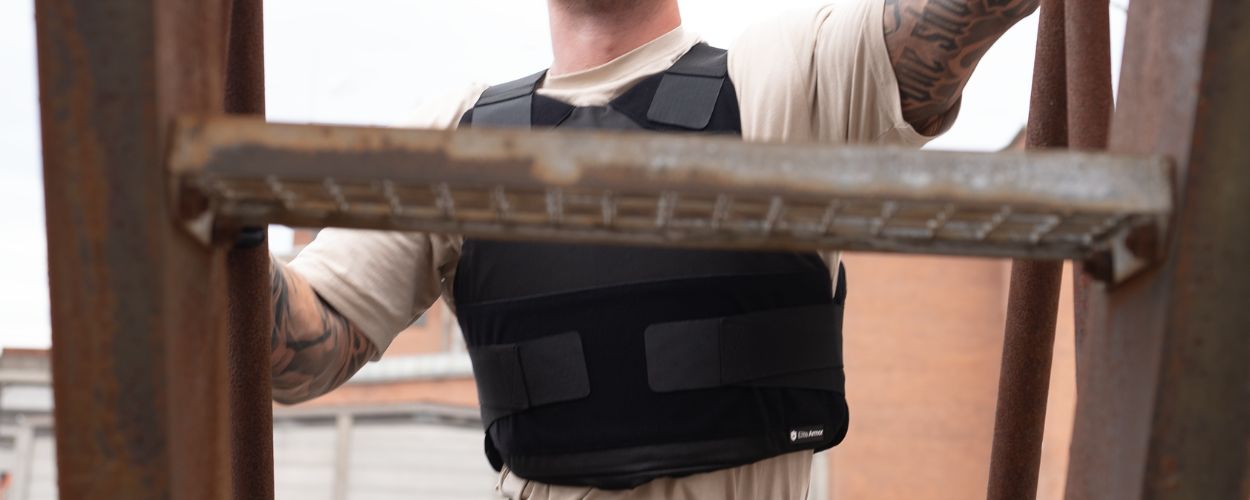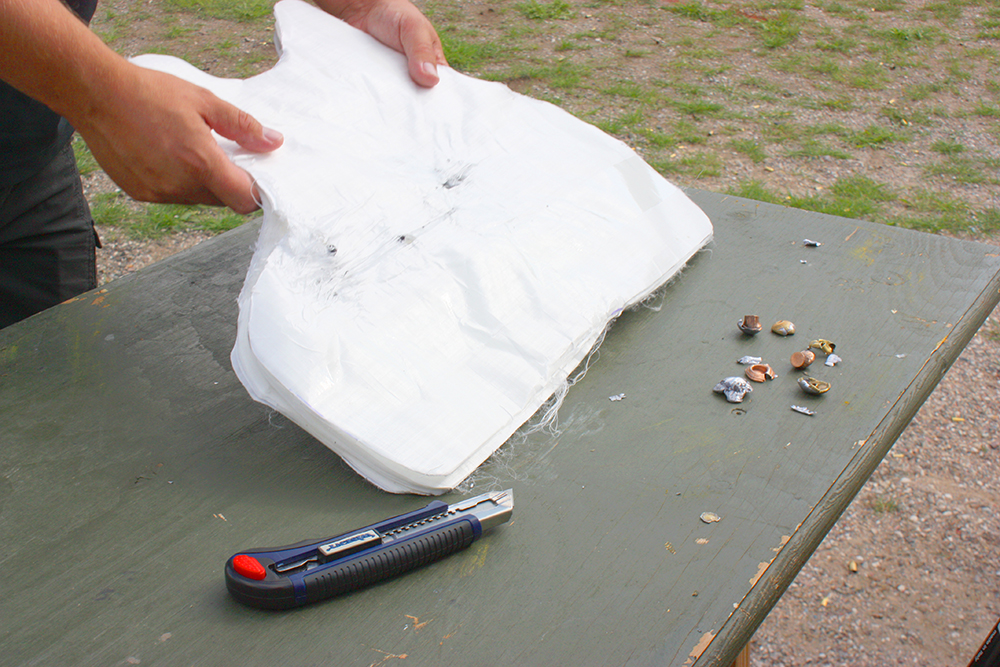 25 Things You Didn’t Know About Bulletproof Vests & Stab-Resistant Vests1. Is a bulletproof vest 100% bulletproof? The reality of bulletproof vests is that they are not 100% bulletproof, but rather bullet-resistant. A bulletproof vest is fundamentally only bulletproof within the standards it is certified for. Some manufacturers' vests may withstand more than what is stated in the specifications.  2. Is a stab-resistant vest 100% stab-resistant? A stab-resistant vest is not protected against everything. The vest is certified within a standard and at a certain level. Exposed to more than it is certified for, the vest can become penetrable by knives or similar objects. The stab-resistant vest will protect you against knife attacks that occur in public environments. An example of how a stab-resistant vest can become penetrable is if a person is lying flat on the ground, and another person sits on them and drags a knife over their head to then stab down into the vest multiple times at the same spot. 3. How does the material stop the bullet in a bulletproof vest? The vests consist of very strong non-woven and woven fibers. The material stops a bullet in the same way that a net would stop a tennis ball or volleyball. It causes the bullet to spin, slows it down, and distributes the energy over the entire panel. Keep in mind that the slower the bullet is, the better it is for the wearer. Bullets that have a hard tip or are fired at high speed can penetrate the fibers and go right through the bulletproof vest. 4. Every bullet is deadly. Many gun enthusiasts overlook the deadly potential of bullets. A simple bullet—small or large—that flies at high speed can penetrate a bulletproof vest. Larger firearms, such as a .44 Magnum or a .45 ACP, fire at a slower speed, making it possible for the vest to stop them. The speed of a .357 SIG and a 9mm pistol is faster and therefore may not be stopped as easily. 5. What is the lifespan of a bulletproof vest? The National Institute of Justice, also known as NIJ, has a minimum five-year warranty on bulletproof vests. When a vest is used daily, it obviously wears out and thus also loses its protective function faster than if it just sits on a shelf. The vest should be checked for damage—including scratches, odors, burns, etc. 6. The warranty card. Always ensure that the sender fills out the warranty card when registering a vest. If they do not do this, it is important that you do it yourself. The reason for this is that it makes it easier for the sender to contact customers regarding, for example, a recall or similar. The warranty card is often your invoice. 7. Wash your bulletproof vest – but only the covers! It might be a good idea to have at least two covers for the vest so that you always have one cover even if the other is being washed. It is indeed possible to wash the covers of bulletproof vests—but it is very important to remember that the plates must NEVER be washed! Therefore, the plates should ALWAYS be removed before the vest goes into the washing machine. Keep the plates dry to ensure they last the full five years. 8. How do you clean the plates of the vest? When you clean the plates of the vest, you must use a damp sponge or cloth. You should never throw them in the washing machine or dryer, and they should not be ironed either, as the fibers may burn or melt depending on what the vest is made of. 9. How do you store the vest? The plates consist of several layers of fibers, meaning that if they are bent or deformed, it is not possible to straighten them again. Depending on the type of bulletproof vest you have, it may vary whether a vest benefits from being hung. It is therefore recommended that you lay the vest on a shelf. 10. Does a bulletproof vest have to get wet? The worst idea you can have is to swim with your bulletproof vest on. The reason for this is that some bulletproof vests lose the performance of the plates, as water acts as a lubricant. When this happens, the vest becomes less responsive to the bullet. However, keep in mind that some manufacturers have treated their vests with water-repellent material so that they can also be used in water. If liquid is spilled on your vest, it is important to wipe the plates with a damp sponge or cloth, and then place the vest on a drying rack until it is properly dry. 11. Consider your vest as clothing. It is important to view the cover of your bulletproof vest as an ordinary piece of clothing and treat it accordingly. That is, it should also be washed like any other laundry. 12. After being shot, you can still fight back. It is not uncommon for bullets to go through a vest, allowing one to still fight back. A vest reduces the risk of death when shot. It also depends on how and where one is hit. A vest can protect you, but if the bullet hits the wrong place or is not stopped, it can still affect your ability to fight back. There have been reported cases where the wearer has managed to continue after being shot, but there is always a risk of losing balance. 13. Know your vest. It is important to be familiar with your bulletproof vest. This includes both how to use the vest and how it is constructed. Learn how to adjust the vest and which parts provide protection. Also, regularly check the condition of the vest. 14. Bulletproof vests require a certain level of physical fitness. To have good protection, it is important that the vest fits closely to the body. This requires that you are in relatively good shape. If the vest hangs too much, it will not provide sufficient protection. Therefore, it is necessary to train and stay fit. 15. There are several levels of bulletproof vests. It is important to be aware that there are different levels of bulletproof vests. They range from level IIA to NIJ IV. Each level has specifications for what the vest can handle and what it cannot. Therefore, you should always consider what type of threat you may face. 16. Not all bulletproof vests are the same. There is a significant difference in quality and protection among the various bulletproof vests available on the market. It can be tempting to save money and buy a cheap vest, but that does not necessarily provide the protection you need. It is always best to invest in quality rather than quantity. 17. A bulletproof vest is not for dummies. A bulletproof vest can be dangerous if not used correctly. Wearing a vest instead of using common sense or avoiding threatening situations can be more harmful than helpful. It is crucial to use your judgment in conjunction with the vest to achieve optimal protection. 18. A bulletproof vest cannot replace medical care. Even though a bulletproof vest can protect against bullets, there is no guarantee that you will survive if shot. Medical care and doctor visits are always necessary if you are shot, even when wearing a bulletproof vest. Believing that you can survive without seeking medical help is a huge mistake. 19. Size matters. It is important to choose a vest that fits. A vest that is too small or too large will not provide optimal protection. Make sure to choose a vest that fits well for your body type, and remember to adjust it so that it sits well. 20. It is okay to be nervous. It is perfectly normal to feel nervous before having to use a bulletproof vest. It can be a stressful situation, and it is important to acknowledge and handle your feelings in a healthy way. 21. A bulletproof vest is a life-changing investment. If you live in an area where there is a high risk of violence or threats, a bulletproof vest can be a life-changing investment. It provides a sense of security and can be the difference between life and death. 22. You must always keep bulletproof vests in mind. Always be aware of your surroundings. If you wear a bulletproof vest, it is important to keep it in mind and consider how it affects the situation. It is crucial to act correctly if the situation becomes dangerous. 23. Learn how to use your vest correctly. If you wear a bulletproof vest, it is important to learn how to use it. This may include knowing how to adjust the vest, how well it fits, and how to put it on and take it off. Using the vest incorrectly can actually make the situation more dangerous. 24. Bulletproof vests can be comfortable. There are many bulletproof vests on the market designed to be comfortable to wear. Consider trying different models to find one that fits you best. A comfortable vest can provide better protection since you are more likely to wear it if it is comfortable. 25. Different types of threats. Be aware that there are many types of threats out there. A bulletproof vest can protect you against certain threats, but not all. Therefore, consider what type of threat you are most exposed to, and choose a vest accordingly. Consider combining the vest with other security measures for optimal protection. |
